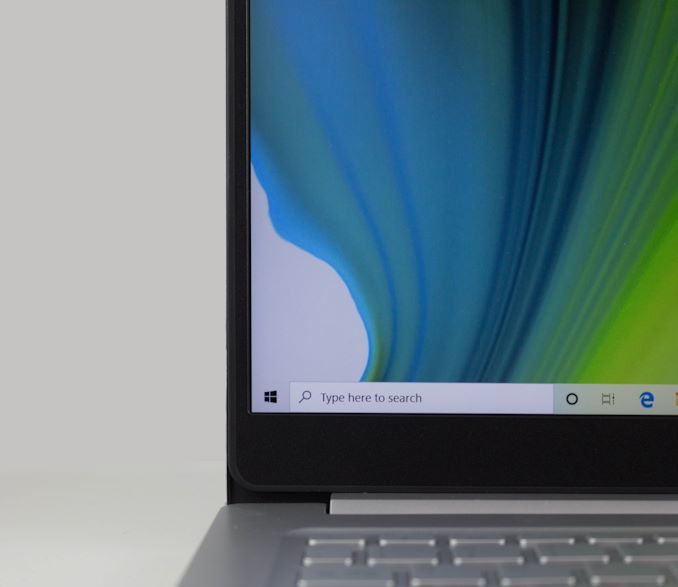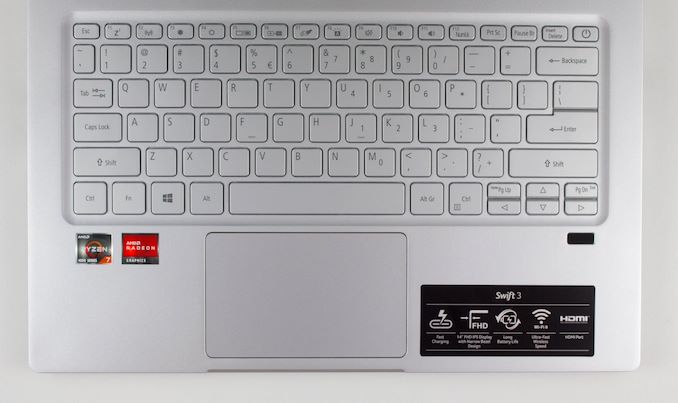The Acer Swift 3 SF314 Notebook Review: Swift Gets Swifter With Ryzen 4000
by Brett Howse & Andrei Frumusanu on May 5, 2020 8:00 AM ESTDesign
Acer’s design ethos for the new Swift 3 would make you think this is a much more expensive device. The 14-inch notebook features an all-aluminum design, offering a much more premium feel than what you’d normally expect on a notebook in this price range. At just 1.2 kg / 2.65 lbs, the 14-inch notebook is extremely portable, and with an 83% screen to body ratio, it is easily as compact as a 13.3-inch notebook from a couple of years ago. Acer’s choice of a 16:9 display does mean that the display has a hefty chin, but is almost certainly a choice that was made to keep the device in-budget.
Despite the thin design and the low price, the aluminum chassis is very stout, with little to no flex no matter how you pick it up. Acer has cut in a slot at the front to make opening the laptop easier, although it will not open with a single finger since the hinge is too stiff to allow this. There is no touch support either, so the hinge stiffness does not need to be quite so tight, but it does make for a solid platform once you open it up.
The keyboard provides a great typing experience. The keys themselves have single-level white backlighting, which works well. The white backlighting on silver keys can cause some contrast issues in bright light, but the effect is not as pronounced as it is on some other devices. Typing offers a surprisingly good keyboard feel, with solid keys that have a solid level of pressure and feedback. Acer has the power button as part of the keyboard, which does make it prone to accidentally turning the device off if you miss the delete key, and moving the power button out of the normal keys would be appreciated, but Acer is far from the only manufacturer to do this, and the laptop resumes instantly so even if it did happen it’s not as big of an issue as it was a few years ago, thanks to the new modern standby options built into Windows and the new CPU.
If there was one area where the notebook showcased it was a lower-cost device, it would be the trackpad. Although it offers the Precision touchpad drivers, the material is not as smooth and responsive as some higher-priced notebooks. This is not so much a knock against the device, but a reality of where it is situated in the market. It does offer the expected multi-touch capabilities you’d expect, it just doesn’t quite offer the level of refinement you’d see in more premium notebooks.
Acer has also included a fingerprint reader, which has great response. It unlocks the device in well under a second even if the display is off. It is a nice to see Windows Hello support despite the lower cost of this device, and the chosen reader seems to work very well. There is no IR camera included, and the built-in webcam is only a 1280x720 unit, so do not expect to be the belle of the Teams meeting, but it gets the job done with a properly located webcam in the top bezel.
Acer offers reasonable I/O as well, with a USB Type-C port on the left, which does support power delivery up to 15 Watts output, and support for charging the device via USB-C as well. There is no Thunderbolt 3, but it does offer DisplayPort output. This is in addition to the included HDMI port, and the laptop also has a USB 3.2 Gen 1 port on the left which supports power-off charging, and a USB 2.0 port on the right, along with a headset jack.
Overall, the Acer Swift 3 is a great design, with a modern feel, and premium materials. The 14-inch notebook is compact, thin, and light, and Acer has done a great job with the look and feel of this device. There are enough ports, and the included USB-C port adds the expanded ability to charge as well as I/O. Looking at this device, you could easily mistake it for a notebook that costs hundreds more.














191 Comments
View All Comments
Samus - Tuesday, May 5, 2020 - link
Wow.watzupken - Tuesday, May 5, 2020 - link
Not sure if anyone pointed out as a feedback, but the legend and the numbers on the axis on the thermal related graphs are too small to see.Anyway, I actually don't find it surprising the performance is once again held back by poor cooling. Considering this is a 1.2KG 14 inch laptop, it should not come across as surprising. We need to consider the fact that this is a proper 8 core processor with a fast GPU. While light is good, but I feel we have gone passed a reasonable/ sensible pushed for slimmer and ligher laptops. Slimmer/ lighter generally means compromising on battery, and/or, cooling.
Brett Howse - Wednesday, May 6, 2020 - link
You can click on the image to get a full-sized version of the thermal graphswatzupken - Wednesday, May 6, 2020 - link
Yeah, I figured out later, but unable to amend my post. Perhaps you folks should consider putting in an edit button here.neblogai - Wednesday, May 6, 2020 - link
There may be an issue with the sample Anandtech got. Cooling is generally praised in other reviews of the same laptop, it does not go over 70C at sustained loads (18W). Also, here is FarCry5 running perfectly fine of Swift3 (4500U, but same at the same 18W): https://youtu.be/TvVaJ5jlgsQHowever, if you look at the graphs Anandtech posted- especially the first graph is telling: at 18W, temps go up slowly from ~65C to ~70C, but then suddenly jump to ~95C, with a hard throttle as a result. Something is failing in their unit, a properly functioning cooling would not be behaving like this.
SkillTim - Wednesday, May 6, 2020 - link
Can someone explain:According to Wikipedia, the 4700U iGPU gives 1433.6 GFLOPS raw performance and the 3780U iGPU gives 1971.2 GFLOPS. Why does this review seem to give the 4700U the win every time in real world performance? Is the review selective? Is Wikipedia wrong? Is the CPU/GPU I/O better in Zen 2?
neblogai - Wednesday, May 6, 2020 - link
1. TFPLOPs is just one paramether- Renoir has higher bandwidth, 2x IF width with iGPU, higher Pixel rate, etc.2. Those Picasso TFLOPs in Wiki, and in AMD slides, are theoretical/marketing speeds, not real life ones. Picasso can not run games at that clock/those TFLOPs, as there is not enough power for it. While Renoir/ is mostly able to keep it's boost/TFLOPs (at least in CPU/light games).
Peskarik - Wednesday, May 6, 2020 - link
Good monitor and bigger battery for 100g more weight and 300 more cost would be welcomed.watzupken - Wednesday, May 6, 2020 - link
If you are looking for better monitor and longer battery life, I think you will need to move up to the Swift 5 series. I observed that Acer have been using very dim monitors (250 nits or lower) on their Swift 3 series for a number of years now and I doubt they will give you a better option to maintain the product segmentation.Peskarik - Wednesday, May 6, 2020 - link
thanks, watzupken